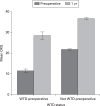'Worse than death' and waiting for a joint arthroplasty
- PMID: 31362549
- PMCID: PMC6681678
- DOI: 10.1302/0301-620X.101B8.BJJ-2019-0116.R1
'Worse than death' and waiting for a joint arthroplasty
Abstract
Aims: The EuroQol five-dimension (EQ-5D) questionnaire is a widely used multiattribute general health questionnaire where an EQ-5D < 0 defines a state 'worse than death' (WTD). The aim of this study was to determine the proportion of patients awaiting total hip arthroplasty (THA) or total knee arthroplasty (TKA) in a health state WTD and to identify associations with this state. Secondary aims were to examine the effect of WTD status on one-year outcomes.
Patients and methods: A cross-sectional analysis of 2073 patients undergoing 2073 THAs (mean age 67.4 years (sd 11.6; 14 to 95); mean body mass index (BMI) 28.5 kg/m2 (sd 5.7; 15 to 72); 1253 female (60%)) and 2168 patients undergoing 2168 TKAs (mean age 69.3 years (sd 9.6; 22 to 91); BMI 30.8 kg/m2 (sd 5.8; 13 to 57); 1244 female (57%)) were recorded. Univariate analysis was used to identify variables associated with an EQ-5D score < 0: age, BMI, sex, deprivation quintile, comorbidities, and joint-specific function measured using the Oxford Hip Score (OHS) or Oxford Knee Score (OKS). Multivariate logistic regression was performed. EQ-5D and OHS/OKS were repeated one year following surgery in 1555 THAs and 1700 TKAs.
Results: Preoperatively, 391 THA patients (19%) and 263 TKA patients (12%) were WTD. Multivariate analysis identified preoperative OHS, deprivation, and chronic obstructive pulmonary disease in THA, and OKS, peripheral arterial disease, and inflammatory arthropathy in TKA as independently associated with WTD status (p < 0.05). One year following arthroplasty EQ-5D scores improved significantly (p < 0.001) and WTD rates reduced to 35 (2%) following THA and 53 (3%) following TKA. Patients who were WTD preoperatively achieved significantly (p < 0.001) worse joint-specific Oxford scores and satisfaction rates one year following joint arthroplasty, compared with those not WTD preoperatively.
Conclusion: In total, 19% of patients awaiting THA and 12% awaiting TKA for degenerative joint disease are in a health state WTD. Although specific comorbidities contribute to this, hip- or knee-specific function, mainly pain, appear key determinants and can be reliably reversed with an arthroplasty. Cite this article: Bone Joint J 2019;101-B:941-950.
Keywords: Health-related quality of life; Hip arthroplasty; Knee arthroplasty.
Figures







References
-
- Dolan P. Modeling valuations for EuroQol health states. Med Care 1997;35:1095-1108. - PubMed
-
- Luo N, Chew LH, Fong KY, et al. . A comparison of the EuroQol-5D and the Health Utilities Index mark 3 in patients with rheumatic disease. J Rheumatol 2003;30:2268-2274. - PubMed
-
- Harrison MJ, Davies LM, Bansback NJ, et al. . Why do patients with inflammatory arthritis often score states “worse than death” on the EQ-5D? An Investigation of the EQ-5D classification system. Value Health 2009;12:1026-1034. - PubMed
-
- Gaujoux-Viala C, Fautrel B, Guillemin F, et al. . Who are the patients with early arthritis with worse than death scores on the EQ-5D? Results from the ESPOIR cohort. Rheumatology 2013;52:832-838. - PubMed
-
- Jenkins PJ, Clement ND, Hamilton DF, et al. . Predicting the cost-effectiveness of total hip and knee replacement: a health economic analysis. Bone Joint J 2013;95-B:115-121. - PubMed

